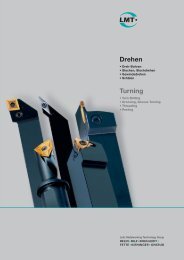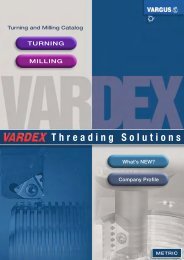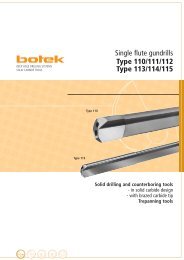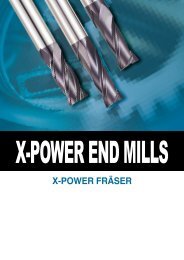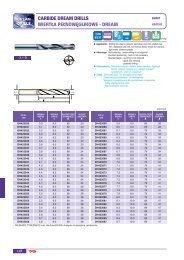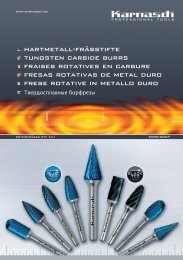Gear Cutting Tools
Hobs - Torion
Hobs - Torion
- No tags were found...
You also want an ePaper? Increase the reach of your titles
YUMPU automatically turns print PDFs into web optimized ePapers that Google loves.
Axial feed f a<br />
[mm/workpiece rotation]<br />
The axial feed is specified in mm<br />
per workpiece rotation.<br />
Owing to the large number of parameters<br />
which influence the machining<br />
process during hobbing,<br />
experience has shown that the axial<br />
feed is best specified as a function<br />
of the tip chip thickness.<br />
Workpiece<br />
h 1 max<br />
h 1 max = 4.9 · m · Z (9.25 · 10 –3 · β 0 – 0.542)<br />
2 · e –0.015 · β0 ·<br />
r a0<br />
· e –0.015 · xp (–8.25 · 10 –3 · β 0 – 0.225)<br />
·<br />
· i –0.877 ·<br />
m<br />
f 0.511 a a 0.319<br />
·<br />
m<br />
· [mm]<br />
m<br />
Centre of hob<br />
The tip chip thickness is the theoretical<br />
maximum chip thickness removed<br />
by the tips of the hob teeth.<br />
The tip chip thickness is regarded<br />
as a criterion for the hob stress;<br />
high tip chip thicknesses mean<br />
high cutting forces and short tool<br />
life.<br />
The tip chip thicknesses are increased<br />
when the module, axial<br />
feed, cutting depth and number of<br />
starts are increased. The tip chip<br />
thicknesses are reduced when the<br />
number of gear teeth, hob diameter<br />
and number of gashes are increased.<br />
Example:<br />
m = 4<br />
Z 2 = 46<br />
<strong>Cutting</strong> depth<br />
ß 0 = 16<br />
x P = 0,2<br />
r a0<br />
i<br />
= 55<br />
= 12/2<br />
r a0<br />
f a<br />
a<br />
m<br />
Z 2<br />
ß 0<br />
x P<br />
r a0<br />
i<br />
f a<br />
a<br />
e<br />
= 4<br />
= 9<br />
Module<br />
Number of teeth<br />
Helix angle (radian)<br />
Profile displacement factor<br />
Half hob diameter<br />
Number of gashes/number<br />
of starts<br />
Axial feed<br />
<strong>Cutting</strong> depth<br />
2,718282<br />
h 1 = 0,3659 Dissertation by Bernd Hoffmeister 1970<br />
Maximum tip chip thickness<br />
=<br />
=<br />
=<br />
=<br />
=<br />
=<br />
=<br />
=<br />
=<br />
Hoffmeister [2] has devised a formula<br />
for the maximum tip chip<br />
thickness.<br />
If this formula is transposed, the<br />
axial feed can be calculated as a<br />
function of the other gear parameters.<br />
Experience has shown a tip<br />
chip thickness of 0.2 to 0.25 mm<br />
to be a realistic value.<br />
For economic reasons, as high an<br />
axial feed as possible is aimed for,<br />
as the machining time is reduced<br />
proportional to the increase in<br />
feed.<br />
Note however that the depth of the<br />
feed markings increases quadratically<br />
with the axial feed, and that<br />
different maximum feed marking<br />
depths are permissible according<br />
to the machining step such as finish-milling,<br />
rough-hobbing prior to<br />
shaving, or rough-hobbing prior to<br />
grinding, depending upon the gear<br />
quality or the allowance.<br />
If carbide hobs are employed for<br />
machining from the solid, the maximum<br />
tip chip thickness must be<br />
between 0.12 and 0.20 mm. For<br />
carbide hobbing without cooling<br />
Z<br />
t h = 2 · d a0 · π · (E + b + A)<br />
[min]<br />
Z 0 · f a · V c · 1000<br />
t h [min]<br />
Z 2<br />
d a0 [mm]<br />
E<br />
b<br />
A<br />
Z 0<br />
[mm]<br />
[mm]<br />
[mm]<br />
f a [mm/WU]<br />
V c [m/min]<br />
=<br />
=<br />
=<br />
=<br />
=<br />
=<br />
=<br />
=<br />
=<br />
Machining time<br />
Number of teeth of<br />
the gear to be cut<br />
Tip circle diameter<br />
of the hob<br />
Lead length<br />
of the hob<br />
Tooth width of the<br />
gear to be cut<br />
Idle travel distance<br />
of the hob<br />
Number of starts<br />
of the hob<br />
Axial feed<br />
<strong>Cutting</strong> speed<br />
Machining time (production time)<br />
for hobbing<br />
lubricant, in particular, 80% of the<br />
heat generated by the cutting process<br />
must be dissipated by the<br />
chips. Adequate chip cross-sections<br />
are therefore required. For<br />
this reason, the tip chip thickness<br />
should not be less than 0.12 mm.<br />
δ x<br />
d<br />
δ x [mm] =<br />
f a<br />
2<br />
fa<br />
·<br />
cos β 0<br />
sin α n<br />
4 · d a0<br />
δ x [mm] = Depth of the feed<br />
marking<br />
f a [mm/wr] = Axial feed<br />
β 0<br />
= Helix angle<br />
α n<br />
d a0 [mm]<br />
= Profile angle<br />
= Tip circle diameter<br />
of the hob<br />
Depth on the feed markings<br />
159



